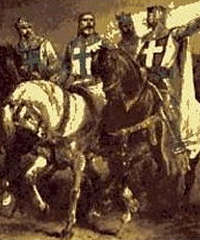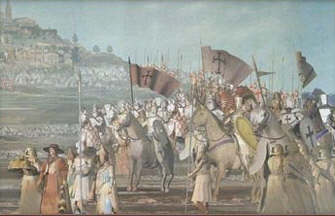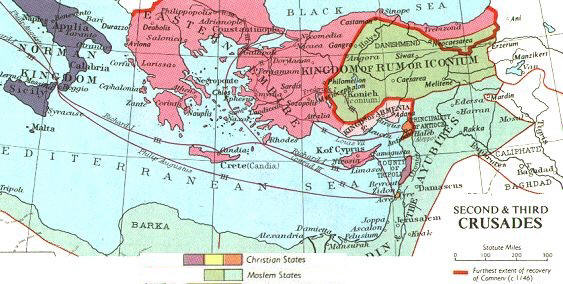Bible
TruthAbridging the Bible
Reformation
Leaders
Faith
or Works?
Free
Will or
Predestination?
Changeable
Truths.
The
Virgin Mary.
Queen
of Heaven
Images and Miracles
Communion:
Memorial or Sacrifice?
By
Their Fruits You
Shall Know Them.
Heaven
and Hell.
The Crusades
The Da Vinci Con
Which
is the True Church?
HOME
PAGE
|
A Just War?Today we are often told that the
Crusades were a shameful episode in the history of
Christianity - a period when intolerant Christians,
lusting for wealth and power, attacked and laid waste a
peaceful, cultured and tolerant Islamic society. But how
true is this picture?
UNPROVOKED ATTACK OR
DEFENSIVE WAR?
Until about 40 years ago, the
public image of the Crusaders was of the most noble of
chivalric knights who rode bravely into battle to defend
Christendom from dire threat.
 Now we are seeing
an extreme swing of the pendulum the other way, and the
perception is completely reversed. Many people have an
image of the Crusades as a shameful episode of unprovoked
Christian brutality and aggression. This has been largely
due to the efforts of modern Revisionists who have
completely re-written the story of the Crusades. Now we are seeing
an extreme swing of the pendulum the other way, and the
perception is completely reversed. Many people have an
image of the Crusades as a shameful episode of unprovoked
Christian brutality and aggression. This has been largely
due to the efforts of modern Revisionists who have
completely re-written the story of the Crusades.
So Which Version
is True?
The answer can be found by anyone
who cares to do the research. A history book written 50
or more years ago will tell a far more detailed story
than most modern ones. An older history will relate all
the known facts in a detailed, step by step manner,
explaining the personalities involved, the lead up to the
conflict and every event along the way. Today's histories
are far lazier, and tend to give only a general overview
of what the writer believes are the most important
events, with little precise detail, and in what is more a
themed than a step by step account. These methods leave
events far more open to being twisted by an opinionated
writer. What detail is added, tends to be odd stories to
add colour and "prove" the writers point.
This mode of history writing has
tended largely to ignore the events that led up to and
formed the context of the Crusades.
Christianity Under
Attack
In the period of time between the mission of Christ and
the 6th century, Christianity had spread across the
Middle East, Turkey, North Africa and Europe. This growth
was almost entirely by peaceful Evangelization, often in
the face of bitter persecution. By 600 AD most of the
former Roman Empire, North Africa and much of Europe were
solidly Christian.
However, from 600 AD onward, Islam
emerged from the Arabian peninsula as an aggressively
expanding religion, which aimed to conquer all the lands
of the region. This continuous war or "jihad"
began just three years after Muhammad's death and
continued for the next thousand years. In this time
Muslim armies overran the Christian Lands of
Syria, Jordan, Lebanon and Palestine 630
AD
Egypt 650 AD
North Africa, Libya, Tunisia, Algeria, Morocco
700 AD
Spain 780 AD
Southern France 790 AD
Sicily 850 AD
Southern Italy 860 AD
Turkish borders 900 AD
Armenia and Georgia 1050 AD
Central Turkey 1070 AD
Greece 1300 AD
Bulgaria, Serbia and the Balkans 1400 AD
Constantinople 1450 AD
Of all the churches mentioned in the New Testament, only
a single one, Rome, escaped Muslim domination.
In addition, piratical raids and campaigns of raiding on
land, slave-taking and slaughter took place virtually
every summer for a thousand years, both to acquire
plunder, and to destabilise and weaken neighbouring
Christian lands. No permanent peace with "infidels"
was allowed by Islam.
Islam's scriptures, the Koran, make
the approach to non-muslims clear:
"Make war on them until idolatry
shall cease and God’s religion shall reign supreme" (8:39)
"Prophet,
rouse the faithful to arms. If there are twenty steadfast
men among you, they shall vanquish two hundred; and if
there are a hundred, they shall rout a thousand
unbelievers, for they are devoid of understanding." (8:65)
"Fight
against such of those to whom the Scriptures were given
... and do not embrace the true Faith, until they pay
tribute out of hand and are utterly subdued." (9:29)
"Slay the idolaters wherever you find
them. ... lie in ambush everywhere for them. If they
repent and take to prayer and render the alms levy, allow
them to go their way ..." (9:5)
The Koran contains many similar verses.
In fact, most Muslim Scholars see the world as divided
into two "houses"—the House of Peace (Dar
Al-Salaam) and the House of War (Dar Al-Harb). The lands
controlled by Muslims belong to the House of Peace, while
those who have not yet submitted to Islam belong to the
House of War until they are "utterly subdued."
So the entire context of the
eastern Crusades is one of response to
continuous Islamic aggression.
What was the
Immediate Cause of the Crusades?
The Crusades had two immediate
causes. The first was the attacks by Muslims upon
pilgrims going to Jerusalem, and destruction of the
shrines there. The second, equally important was an
appeal for help from the Eastern Christians who were
suffering a renewed Islamic invasion by the Seljuk Turks.
In 1095 Pope Urban the Second called for Christians to
unite in a Crusade.
From Pope Urban II's
call at the Council of Clermont in 1095
Freshly
quickened by the divine correction, you must apply the
strength of your righteousness to another matter which
concerns you as well as God. For your brethren who live
in the east are in urgent need of your help, and you must
hasten to give them the aid which has often been promised
them. For, as the most of you have heard, the Turks and
Arabs have attacked them and have conquered the territory
of Romania [the Greek empire] as far west as the shore of
the Mediterranean and the Hellespont, which is called the
Arm of St. George. They have occupied more and more of
the lands of those Christians, and have overcome them in
seven battles. They have killed and captured many, and
have destroyed the churches and devastated the empire. If
you permit them to continue thus for awhile with
impurity, the faithful of God will be much more widely
attacked by them. On this account I, or rather the Lord,
beseech you as Christ's heralds to publish this
everywhere and to persuade all people of whatever rank,
foot-soldiers and knights, poor and rich, to carry aid
promptly to those Christians and to destroy that vile
race from the lands of our friends. I say this to those
who are present, it is meant also for those who are
absent. Moreover, Christ commands it.
So were the
Eastern Christians really in mortal Danger?
The answer is yes. A new wave of
conquest had been launched by the Seljuk Turks, who would
give their name to the land now called Turkey.
This is from a contemporary account
of their attack on Christian Armenia in 1059, 30 years before
the Crusades.
On
Sunday 6th August the siege of Sebastea began, as did the
slaughter; thousands of corpses littered the ground. What
a dreadful scene. The bodies of highly renowned men were
piled in a heap as if a forest of trees had been felled.
and the ground was soaked with blood...
They ruthlessly massacred an immense number of people,
carried off booty and took untold numbers of captives,
men and women, young boys and girls, whom they sold into
slavery... Fateful day! In a matter of minutes Sebastea
and the surrounding plain were bathed in blood. The clear
waters of the River Kizil Irmak which cuts through the
city walls, suddenly flowed red.
In 1064 the Turks returned. He made his way towards Armenia and
entered the country; the inhabitants were put to the
sword and driven into slavery. The infidels were so
numerous that they covered the plains and closed off al
the escape routes. Then he invaded Georgia, bringing
death and slavery wherever he went. .. The Turks
exterminated all the inhabitants, men, women, priests,
monks and nobles; the young boys and girls were taken
away captive into Persia.."
Chronicle of Matthew of Edessa.
Then came the Muslim attack on Byzantium in 1071, 20
Years before the Crusades. They killed
and slaughtered thousands in the cities of Anatolia.
reaching to the very gates of Constantinople.
..from
that time right on to my father's reign the barbarian
power was never checked, but swords and spears were
whetted against the Christians and there were battles,
wars and massacres. Cities were wiped out, countries were
laid waste, and the whole Roman (Byzantine) territory was
defiled with the blood of Christians. For some perished
miserably by darts or spears, while others were driven
from their homes and led away captive to the cities of
Persia. And dread seized them all and they hurried to
hide themselves from the dangers that threatened, in the
caves and groves and mountains and hills. Among these
some lamented aloud over the ills which their friends who
had been taken away to Persia were suffering; the few
others who still survived in the Roman lands were sighing
deeply, and lamenting, one for a son, another for a
daughter; or weeping for a brother or a nephew cut off
before his time, and shedding bitter tears like women. In
fact there was no condition of life free from tears and
groans.
From the 'Alexiad' of the Byzantine Princess Anna
Comnena
All this happened before the first crusader set foot in
the east.
The Crusades were actually from the beginning a defensive
war. Without the united response of the Crusades
the whole of Europe could well have fallen piecemeal to
Islam before 1400.
But didn't the
Crusaders Behave far worse than the Muslims once the
Conflict had begun?
 Again, current
depictions of chivalrous Muslims and brutal Christian
warriors are more modern legend than reality. Modern
historical writers tend to quote in graphic detail any
outrages that were committed by Christian troops whilst
quietly passing over the often greater outrages committed
by Muslims. Again, current
depictions of chivalrous Muslims and brutal Christian
warriors are more modern legend than reality. Modern
historical writers tend to quote in graphic detail any
outrages that were committed by Christian troops whilst
quietly passing over the often greater outrages committed
by Muslims.
Christian armies did sometimes
commit outrages in the heat of battle. However we must
understand that most of those who went east were career
soldiers (much like those who take part in wars today, in
Iraq and elsewhere), who go into battle, kill and are
killed, and who obeyed the often harsh rules of war of
their day.
JERUSALEM
The Christian massacre of several
thousands of the population of Jerusalem immediately
following the capture of the city, is an incident that is
repeatedly quoted as one of particular Christian
brutality - as opposed to the supposed greater leniency
of Saladin when he took the city a hundred years later.
However, as with most such charges, this is a major
distortion of what was really taking place.
The rules of siege warfare at the
time were very clear, and accepted by both sides. Those
rules were that a besieged city was given a choice of
surrendering to an attacking army without further
bloodshed. However if that city resisted assault, and so
needed to be stormed by the besieging army at great cost
of life to the attackers, then the population of the city
were considered combatants, and subject to the fury and
spoil of the attackers. Once a battering ram hit the
gates of a city, the die was cast and all inside could be
subject to attack and treated as enemy. The justification
was, that the citizens had had the chance of a peaceful
hand-over and had rejected it. Jerusalem held out to the
last, and a large number of the Crusaders perished in the
siege and assault.
A massacre was not typical of the
Christian practice on capturing a city, however. In those
Muslim cities that surrendered to the Crusaders the
people were left unmolested, retained their property, and
were allowed to worship freely.
SALADIN
Saladin's capture of Jerusalem, however, was not a
storming. It was a negotiated surrender in which the
Christian inhabitants sought terms for their lives in
return for giving up the city. It is this, rather than
Saladin's tolerance, which accounts for the difference.
Even so, Saladin's terms were considerably harsher than
is normally reported in modern histories.
The
terrified and craven mob kept running to the Patriarch
Heraclius and the Queen Sybilla, who were at that time in
charge of the city. They complained tearfully and urged
that negotiations be started with Saladin immediately
about handing over the city. The pact that followed was
more to be deplored than commended. For each person a
ransom was paid: Twelve sovereigns for a man, five for a
woman, one for a child. Anyone who could not pay was
taken captive. So it happened while a good many people
were able to find the payment for their safety, fourteen
thousand who could not pay went under the yoke of
perpetual slavery... On that day, 2nd October 1187, the
queen of all cities was taken into bondage.
Itinerarium Regis Ricardi
When the Turks captured Jerusalem from the Christians for
a second time, in 1244, 5,700 of 6,000 Christians were
killed or enslaved as they fled the city,
At last
these heathens entered Jerusalem on 11 July 1244 and
brutally disembowelled before the Sepulchre itself, all
the Christians who had stayed behind.
Robert, Patriarch of Jerusalem.
In fact widespread massacres of
Christians by the Muslims were very common, and used as
an instrument of terror by Baybars, the Sultan who
captured much of the Holy Land..
Eyewitness account of the Templar
of Tyre
On
Friday 18th May 1291, before daybreak, there came the
loud and terrible sound of a kettledrum, and as the drum
sounded, the Saracens assaulted the city of Acre on every
side. The place where they first got in was through this
damned tower which they had taken...
That day was appalling, for nobles and citizens, women
and girls were frantic with terror; they went running
through the streets, their children in their arms,
weeping and desperate; they fled to the sea shore to
escape death, and when the saracens caught them, one
would take the mother and another the child, they would
drag them from place to place and pull them apart; and
sometimes two Saracens would quarrel over a woman and she
would be killed; or a woman was taken and her sucking
child flung to the ground where it died under the horses
hooves.
Arab account of the taking of Tripoli.
On
Tuesday 26th April 1289 the Sultan's army entered the
city by force, it population fleeing towards the harbour.
A few of them escaped by boat, though the majority of the
male population were killed, while the children were led
away into captivity. The Muslims took with them a huge
amount of booty. When the Muslims had ceased killing and
plundering the people of Tripoli, the Sultan ordered it
be razed to the ground. In the sea near Tripoli there was
an island, on which stood a church named the church of St
Thomas. when the Muslims took Tripoli, many of the women
fled to the church there.
Defying the sea, the Muslim army made the crossing to the
island, swimming with their horses. They killed the
menfolk who were there and claimed as booty the women and
children and property. After this island had been cleared
of all plunder, I crossed over in a boat. I found it
covered in corpses which were putrefied to such an extent
that the stench made it impossible to remain there.
Abu al-Fida
Similar accounts have survived from Michael the Syrian
reporting the massacre at Edessa in 1144. And that of
Sultan Baybars himself, reporting the massacre and
destruction of Christian Antioch. So completely was the
city destroyed, that Antioch, once one of the four
greatest cities of the East, never recovered. Even today,
all that remains is just an insignificant village.

So why are the Crusades
now so Misrepresented in the West?.
The change of the image of the
Crusaders from noble paladins to brutal Imperialists has
been driven by:
1. A feeling of guilt amongst modern intellectuals over
recent colonialism. Muslims have been seen as being
victims of the West, and this world-view was then
projected backward on the Crusades. To "compensate"
for recent western dominance, past Muslim misdeeds were
overlooked, and Christian ones were exaggerated and
emphasized.
2. The need of many in modern
society to try to tear down the specifically Christian
roots of Western civilisation. Such people like to
promote the view that modern society developed despite
Christianity, rather than because of it.
So they run down Christianity's huge contribution to
society, progress and civilisation, and over-emphasize
any negatives.
3. The desire of modern historians
to have something "new" to say in order to make
their reputations. So if the standard view of the
Vikings, for example, is that they were murderous
destroyers, the revisionist will try to argue that they
were cultured, caring intellectuals.
However, this "Christian-hating" view of the
crusades is counter-productive, since it encourages an
unjustified sense of grievance against Christians in the
Islamic world. It also protects Muslims from the need to
face and modify their own aggressive historical
tendencies.
|

